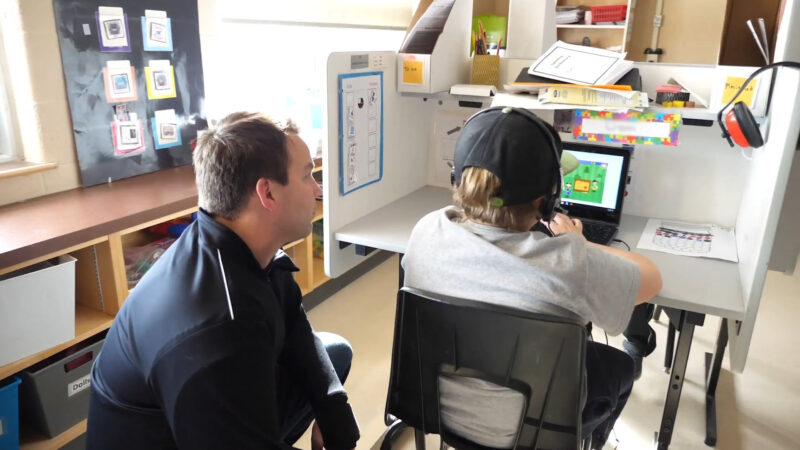“The art of teaching is the art of assisting.” This quote perfectly encapsulates the role of an education assistant, a vital cog in the machinery of our education system.
Education assistants provide the much-needed support that teachers and students rely on for a successful learning experience. They are the unsung heroes who work behind the scenes, ensuring that the classroom environment is conducive to learning and that each student gets the attention they need to thrive.
If you’re considering a career as an education assistant, you’re in the right place. This comprehensive guide will walk you through the steps to becoming an education assistant, from understanding the role and its requirements to choosing the right education path and obtaining certification.
We’ll also delve into the costs involved, the potential for career advancement, and the rewards of choosing this career path.
What Does an Education Assistant Do?
Education assistants, often referred to as teacher assistants or teacher’s aides, are integral members of the educational community. They work hand-in-hand with teachers, playing a vital role in shaping the learning environment within the classroom.
Their responsibilities can be diverse and multifaceted, often varying based on the specific age group or educational level of the students they are working with. However, several core duties are central to the role of an education assistant.
Supporting Instruction
Helping with instruction is one of an education assistant’s main responsibilities. This can entail a variety of jobs, such as helping to create lesson plans or delivering content under the teacher’s supervision.
In order to facilitate the learning process, they could also assist in developing and preparing educational materials like handouts or visual aids.
Grade-related tasks
Grading coursework and exams is a common task for education assistants. By grading homework, tests, and other forms of assessment, they assist teachers in managing their workload.
Students also receive feedback from teachers, which helps them recognize their strengths and areas for development.
Classroom Management

Managing the classroom is undoubtedly one of the most critical and multifaceted roles performed by an education assistant. Beyond providing support to teachers, they play an indispensable part in creating a harmonious and effective learning environment where students can thrive academically and emotionally.
One of the primary responsibilities of an education assistant in classroom management is to foster a positive and productive atmosphere. They achieve this by skillfully enforcing classroom rules and behavioral expectations, which are essential for maintaining order and discipline.
By setting clear boundaries and consistently reinforcing them, education assistants help students understand the importance of respecting rules, cultivating self-discipline, and exhibiting appropriate conduct, all of which contribute to a conducive learning environment.
Providing Additional Support
Perhaps one of the most important roles of an education assistant is providing additional support to students. They work closely with students who may need extra help, offering one-on-one or small-group assistance to those who may be struggling with a particular topic.
This can involve explaining concepts in different ways, providing additional practice opportunities, or offering strategies to help students better understand the material.
In addition, education assistants often provide support to students with special needs, working with them to ensure they have the necessary accommodations and support to succeed in the classroom.
How to Become an Education Assistant
If you’re passionate about education and have a desire to support students in their learning journey, becoming an education assistant could be the ideal career path for you. The process is straightforward and not overly time-consuming, especially if you’re clear about the necessary steps and requirements.
Here’s a comprehensive guide to help you navigate your way:
Step One: Complete Your Education

The first and most crucial step towards becoming an education assistant is to complete your education. The specific educational requirements can vary depending on the job and the school district.
For some positions, a high school diploma or a GED might be enough. However, most teaching assistant positions prefer candidates with an associate’s degree.
If you’re aiming for more advanced roles or considering future career growth, a bachelor’s degree in education or a related field could be beneficial. This degree can provide you with a deeper understanding of educational theories, teaching methodologies, and child development, which are crucial for an education assistant.
Step Two: Consider an Internship
Internships, while not a mandatory requirement, can significantly enhance your profile. They provide you with the opportunity to gain hands-on experience in a real classroom setting.
This practical experience allows you to apply the theoretical knowledge you gained during your degree program and understand the dynamics of a classroom better. Internships also offer networking opportunities, allowing you to connect with professionals in the field.
These connections can be beneficial when you’re looking for job opportunities or need professional advice.
Step Three: Obtain Paraprofessional Certification or Licensure
The requirements for certification or licensure of teacher assistants vary from state to state. Some states may require you to pass a specific test, while others might require you to complete a training program. In some cases, these requirements can be fulfilled during your on-the-job training.
It’s important to research the specific requirements in your state or the state where you intend to work. Obtaining the necessary certification or licensure not only makes you eligible for the job but also enhances your credibility as an education assistant.
Step Four: Start Applying for Teaching Assistant Jobs
Once you’ve fulfilled the educational and certification requirements, you’re ready to start applying for teaching assistant jobs. Ensure that your resume is current and effectively highlights your skills, experiences, and achievements relevant to the job.
When applying, tailor your application to each specific job. Highlight the experiences and skills that best align with the job description.
Remember, the application process is your opportunity to showcase your passion for education and your readiness to contribute positively to a learning environment.
Time & Cost: Paraprofessional Certification
One of the appealing aspects of becoming an education assistant is that it’s both affordable and not overly time-consuming. For instance, the average cost of tuition and fees for a two-year institution was reported to be $3,621 in 2020.
Beyond earning a degree, there are other ways to meet hiring requirements. Some states allow prospective education assistants to take an assessment, such as the ACT WorkKeys test or the ParaPro Assessment, as an alternative to traditional degree programs.
Education Requirements for an Education Assistant
The educational requirements for becoming an education assistant are quite flexible. While an associate’s or bachelor’s degree will provide the best foundation for your career, the specific degree you choose can vary.
Degrees in education or psychology are often the most beneficial for this role, providing a solid understanding of learning theories and human behavior.
Choosing an Online Program for Education Assistants
In today’s digital age, it’s entirely possible to meet all the requirements to become an education assistant online. This option offers flexibility and convenience, especially for those who are balancing other responsibilities such as work or family.
However, it’s crucial to ensure that your online degree is accredited. Accreditation ensures that you’re eligible for licensure and that your education is recognized by professional organizations and employers.
Certification & Licensing for Education Assistants
Certification and licensing requirements for education assistants vary from state to state. Some states require one or more licenses or certifications before you can apply for a job in that state.
Others offer alternative paths with various requirements to achieve paraprofessional certification. It’s essential to research the specific requirements in your state or the state where you intend to work.
Is It Worth It?
Becoming an education assistant is a rewarding career choice with many benefits. The education requirements are flexible and affordable, making it an accessible career path for many.
Education assistants have the opportunity to work in various settings, and many states offer license reciprocity, making it easier to move and find work. Finally, working as an education assistant provides a foundation of experience that can lead to opportunities for advancement, such as becoming a teacher or an administrator.
If you’re passionate about education and eager to support students in their learning journey, becoming an education assistant could be the perfect career path for you.
FAQ
What is the work environment for an Education Assistant?
Education Assistants typically work in schools, at childcare centers, and for religious organizations. Most work full-time, although part-time work is common. They generally do not work during the summer.
What is the job outlook for Education Assistants?
Employment of Education Assistants is projected to grow 5 percent from 2021 to 2031, about as fast as the average for all occupations. About 153,700 openings for Education Assistants are projected each year, on average, over the decade. Many of those openings are expected to result from the need to replace workers who transfer to different occupations or exit the labor force, such as to retire.
Are there similar occupations to an Education Assistant?
Yes, similar occupations include preschool teachers, special education teachers, childcare workers, and teacher assistants in higher education. These roles also involve working with students and supporting their learning process.
Moreover, there are additional roles, such as community support workers, which can also be considered similar to education assistants. These professionals provide vital support and assistance to individuals within the community, which may include helping students facing specific challenges and ensuring their educational needs are met.
What skills should I have if I pursue a teaching assistant career?
Some of the skills that can be helpful when pursuing a teaching assistant career include communication, attention to detail, lesson planning, patience, leadership, teamwork, creativity, and multitasking.
Is there on-the-job training for Education Assistants?
Typically, there is no specific on-the-job training for Education Assistants. However, they gain useful job experience by working with students in the classroom environment.
Final Words
In conclusion, becoming an education assistant is a rewarding and accessible career path. It involves completing your education, possibly doing an internship, obtaining certification, and applying for jobs.
As an education assistant, you’ll play a crucial role in the classroom, providing essential support to both teachers and students. This career is not just a job, but a calling for those passionate about education and making a difference in students’ lives.
So, if you’re ready to embark on this journey, start today. Your role in shaping the future of education begins now. Good luck!

